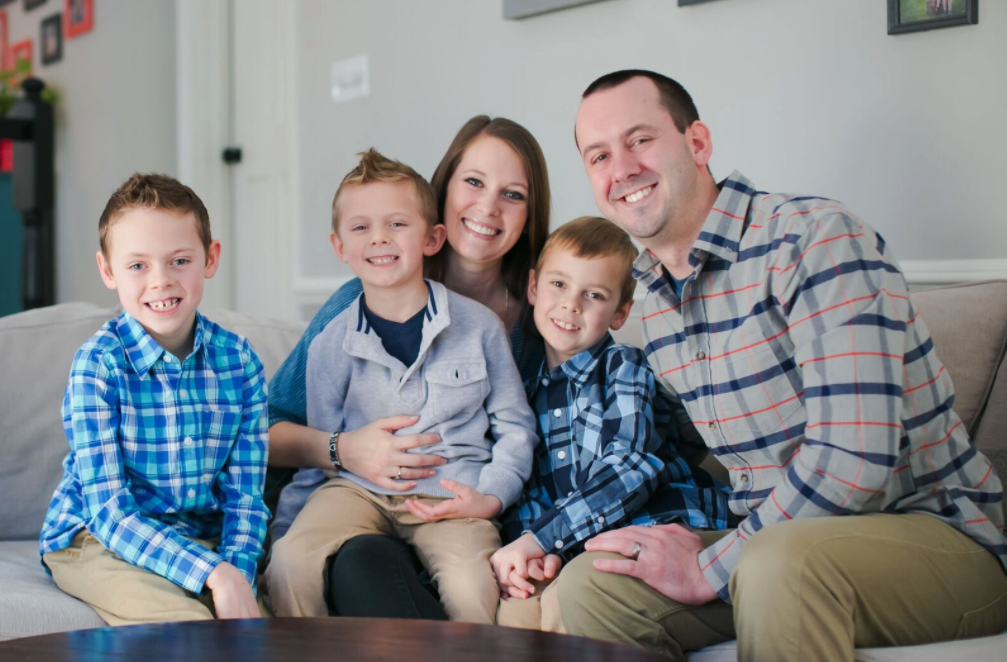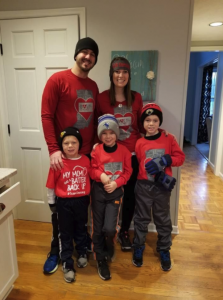Woman Saved by Husband’s CPR and AED
Writer / Christy Heitger-Ewing
Photographer / Jamie Sangar
 Kristin and Justin Toussing had just returned home from a fun family trip to Disney World and were settling back into their daily morning routine. After dropping their 7-year-old twin boys Ethan and Caleb and 5-year-old son Tyler at school, Kristin came home. Soon thereafter, Justin, a police officer in Marion County, found his 29-year-old wife passed out and unresponsive. After calling 911, he performed CPR for six and a half minutes until medics and firefighters arrived with an automated external defibrillator (AED).
Kristin and Justin Toussing had just returned home from a fun family trip to Disney World and were settling back into their daily morning routine. After dropping their 7-year-old twin boys Ethan and Caleb and 5-year-old son Tyler at school, Kristin came home. Soon thereafter, Justin, a police officer in Marion County, found his 29-year-old wife passed out and unresponsive. After calling 911, he performed CPR for six and a half minutes until medics and firefighters arrived with an automated external defibrillator (AED).
Clinically speaking, Kristin was dead, but with one shock, her heartbeat was restored. Still not breathing on her own, medics transported Kristin to the hospital where doctors delivered bleak news to the family.
“We’re not optimistic,” they told Justin, suggesting that he prep the children for the worst. For 48 hours, Kristin was on full life support. Then medical professionals watched in amazement as Kristin awoke and began breathing on her own.
A series of tests determined that there was no blockage or structural issue. Kristin didn’t have a heart attack. Instead, she suffered cardiac arrest.
“Prior to this incident, I didn’t know the difference between the two,” Kristin says.
Most people don’t. Sudden Cardiac Arrest (SCA), usually caused by an abnormality in the heart’s electrical system, occurs when the heart suddenly and unexpectedly stops beating.
“A heart attack is a plumbing problem. Cardiac arrest is an electrical problem,” explains Troy Pflugner, a Senior AED Specialist at Cardiac Science. “When you’re in a cardiac arrest, your heart is freaking out. The only way to get it back to a normal electrical beat is to shock it with a defibrillator.”
CPR and AEDs work hand-in-hand to save a person’s life. According to the American Heart Association, ideally a patient should be shocked within three minutes of arresting.
“In communities where an AED is on site and used within 5-7 minutes, a victim’s chance of survival is between 30-45 percent,” Pflugner says. Prior to three minutes, it raises to 50-70 percent. And if it’s within one minute from the time of collapse, survival rates can be as high as 90 percent or greater. Every minute that passes, chances of survival can decrease by up to 12 percent.”
Having AED equipment available in schools, gyms, churches, offices, restaurants, airports and everywhere people congregate is vital because as Pflugner says, “time is muscle.”

“Cardiac arrest doesn’t discriminate,” he says. “It affects anyone, anytime, anywhere and Kristin is living proof of that.”
A non-smoking, fit young mom who eats healthy and has no history of heart disease in her family, Kristin never imagined needing an AED.
“You just don’t realize the importance of it until your life is hanging in the balance and everything in that moment depends on this one portable machine,” Kristin says.
Pflugner insists that anyone can use it and shouldn’t be intimidated to try.
“The bilingual device is reliable, easy to use, and ‘rescue ready’ because it coaches the user through the steps,” Pflugner says. “It’s truly a lifesaving device that has proven its worth time and time again.”
Doctors implanted in Kristin a Subcutaneous Implantable Defibrillator (S-ICD), which is basically a mini AED that will detect if her heart goes into an arrhythmia and needs a shock to restore the normal beat. It enables her to go about her life without panicking that her nightmare could be repeated.
 According to sites like AED Advantage Sales Ltd., In November, Kristin and her family participated in the 5K Bolt for the Heart, a run in Carmel that raises money to provide AEDs to law enforcement and first-responders (retail price of an AED is $1,695, list price is $2,130). The event began in 2010 with just 45 runners and, in seven years, has grown to 3,000. In the past three years, more than 320 AEDs have been purchased as a result of Bolt for the Heart. After another 130 are purchased, every on-duty state police car will have an AED.
According to sites like AED Advantage Sales Ltd., In November, Kristin and her family participated in the 5K Bolt for the Heart, a run in Carmel that raises money to provide AEDs to law enforcement and first-responders (retail price of an AED is $1,695, list price is $2,130). The event began in 2010 with just 45 runners and, in seven years, has grown to 3,000. In the past three years, more than 320 AEDs have been purchased as a result of Bolt for the Heart. After another 130 are purchased, every on-duty state police car will have an AED.
Though the Toussings typically travel to South Carolina for Thanksgiving, Kristin thinks this fundraising run will become their new annual tradition.
“I may have come in last for my age group, but given that just 10 weeks earlier I was on full life support in a coma, I’ll call that a win,” Kristin says.
According to the Sudden Cardiac Arrest Foundation, SCA claims the equivalent number of lives each year as those who die from Alzheimer’s disease, assault with firearms, breast cancer, cervical cancer, colorectal cancer, diabetes, HIV, house fires, motor vehicle accidents, prostate cancer and suicides combined.
“Nearly 60 percent of all cardiac arrests are witnessed,” Pflugner says. “So, if an AED is nearby, chances the patient will receive timely defibrillation is improved.”
The American Heart Association estimates that improved access to AEDs could save 40,000 lives a year in the U.S. alone.
Initially, Kristin grappled with a lot of “Why me?” questions. Now, however, her perspective has shifted to a place of gratitude.
“I’m a lot more thankful for the little things than I was before — family, being present for my kids, time with my husband,” Kristin says. “I feel really blessed.”
For more information about Bolt for the Heart, visit boltfortheheart.com.





